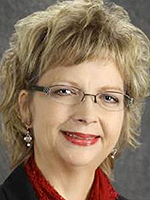Chairman, American Trucking Associations
Opinion: Trucking Can Help Fight Human Trafficking
Cold, young, maybe 16 or 17 years old, and scared. This is how one of our company’s truck drivers described a girl he encountered at a truck stop about a decade ago. In the years since, thanks in large part to its partnership with Truckers Against Trafficking, our industry is in a better position to recognize that young girl as a potential victim of human trafficking.
January is Human Trafficking Awareness Month, but our industry must commit all year to continuing to address the human trafficking crisis happening in our communities from coast to coast.
As a company owner, second vice chairman of American Trucking Associations, advisory committee member for the United States Department of Transportation’s Advisory Committee on Human Trafficking and most importantly as a mother, I ask every trucking industry professional to tap into available resources that can help identify and address human trafficking. It is simple, it is effective and it can save lives.
How can you help? By incorporating Truckers Against Trafficking training into your company’s already existing policies and procedures. Your employees can better understand the issue, learn basic indicators of instances of human trafficking, and see how to take appropriate action to protect victims and assist law enforcement. At Garner Trucking, our truck drivers are trained to be vigilant about this issue as they operate their trucks in communities throughout the country, and we believe that the more truck drivers who take this approach to human trafficking, the bigger difference the industry can make.

Brumbaugh
Businesses Ending Slavery and Trafficking, otherwise known as BEST, provides resources for companies looking to add anti-trafficking policies to their company handbooks, training programs and guidelines. Trucking can also adopt lessons from the U.S. tourism industry, software companies and municipalities to form internal company travel policies, organizationwide value statements, work time policies and entertainment and business expense policies all meant to protect potential victims from sex and labor trafficking while protecting organizational reputations. In other words, there is a business case and moral case for implementing anti-trafficking policies in our companies.
Adding to the employee handbook or organizing companywide training sessions may sound like additional work, but TAT, BEST and other groups engaged on this issue provide tools and resources to make the process as easy as possible. Individual companies don’t have to reinvent the wheel —they just need to use existing materials in smart ways.
National Human Trafficking Awareness Month is, at its most basic level, about awareness. Educating our industry’s drivers, dispatchers and executives about the widespread human trafficking abuses taking place in our neighborhoods and hometowns is the first step in eradicating this despicable crime. Knowing a few basic indicators of human trafficking and how to respond is the next phase if our industry wants to continue making a difference for future generations.
Some of the warning signs drivers should look for are: an individual not having knowledge of their whereabouts or control of their identifications; restricted and controlled communications or not being allowed to speak for himself or herself; CB radio chatter about “commercial company” or flashing lights that signal a buyer location; signs of branding or tattooing of a trafficker’s name (often found on the victim’s neck); a van or RV that seems out of place or a vehicle dropping someone off and picking them up after 15 or 20 minutes.
If you or one of your employees suspect a crime is in progress, dial 911 and then call the hotline. If they see something suspicious at a commercial business, notify the manager on duty. And urge them to pay attention to details; for law enforcement to open an investigation on your tip they need actionable information like a car make and model, color, license plate, description of the perpetrator and victim, time and date, addresses. If you see something, say something.
Importantly, drivers and employees should be advised to not approach traffickers or attempt victim recoveries, as such actions are dangerous and can complicate criminal proceedings.
Even if you don’t implement training, you can help. The U.S. National Human Trafficking Hotline is 888-373-7888. Save that number. Print it out for your drivers. Put it on your dispatchers’ desks.
The amazing power of truckers is that they often get a sense when something doesn’t feel right. Intuition and a gut feeling serve as frequent motivators for making a call. That intuition, combined with a basic understanding of the indicators of trafficking, can be the difference in someone’s freedom or continued cycle of abuse.
I urge you to consider taking steps to combat human and sex trafficking in your community. If you see something, make the call and save a life. President Donald Trump called our drivers heroes, and I truly believe that they are — not just on the road but also in every community.
The first step in combating human trafficking is to talk about it, and get employees involved and trained. One single person can make a difference, and collectively the trucking industry can effect real change with this national problem.
Sherri Garner Brumbaugh is second vice chairman of American Trucking Associations. American Trucking Associations is the largest trade federation in the trucking industry and has headquarters in Arlington, Va., as well as affiliated associations in every state. ATA owns Transport Topics.

